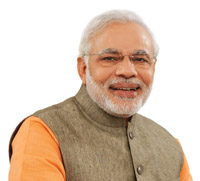PM releases first ever national plan for disaster management
June 02, 2016

New Delhi
The first-ever national plan for disaster management, which encompasses a blueprint for making the country disaster-resilient and significantly reducing loss of lives and livelihoods, was unveiled today by Prime Minister Narendra Modi here.
The National Disaster Management Plan (NDMP) provides a framework and direction to the government agencies for all phases of disaster management cycle — prevention, mitigation, response and recovery.
The NDMP is a dynamic document in the sense that it will be periodically improved keeping up with the emerging global best practices and knowledge bases in disaster management, a Home Ministry statement said here.
The vision of the plan is to make India disaster- resilient, achieve substantial disaster risk reduction, and significantly decrease the losses of life, livelihoods, and assets economic, physical, social, cultural and environmental by maximising the ability to cope with disasters at all levels of administration as well as among communities, the statement said.
“It (NDMP) focuses on disaster resilience and reducing damage during disasters. The comprehensiveness of this plan is noteworthy. It covers all phases of disaster management- prevention, mitigation, response and recovery,” Modi tweeted.
The NDMP provides a generalised framework for recovery since it is not possible to anticipate all the possible elements of betterment reconstruction.
The Prime Minister said to prepare communities to cope with disasters, the plan emphasises on a greater need for information, education and communication activities.
“A regional approach has been adopted in the NDMP, which helps in disaster management and in development planning,” he added.
The Plan also highlights that the disaster risk reduction will be achieved by mainstreaming the requirements into the developmental plans.
Globally, the approach towards post-disaster restoration and rehabilitation has shifted to one of betterment reconstruction.
The NDMP has been aligned broadly with the goals and priorities set out in the Sendai Framework for Disaster Risk Reduction.
For each hazard, the approach used in this national plan for disaster management incorporates the four priorities enunciated in the Sendai Framework into the planning framework for Disaster Risk Reduction under the five Thematic Areas for Actions, the Home Ministry statement said.
The Sendai Framework for Disaster Risk Reduction 2015-2030, adopted at the 3rd UN World Conference on Disaster Risk Reduction in Japanese city Sendai on March 18 last year, outlines seven clear targets and four priorities for action to prevent new and reduce existing disaster risks.
These are — Understanding disaster risk; Strengthening disaster risk governance to manage disaster risk; Investing in disaster reduction for resilience and Enhancing disaster preparedness for effective response, and to “Build Back Better” in recovery, rehabilitation and reconstruction.
The response part of the NDMP has identified 18 broad activities which have been arranged into a matrix to be served as a ready reckoner.
They are early warning, maps, satellite inputs, information dissemination, evacuation of people and animals, search and rescue of people and animals, medical care, drinking water/ dewatering pumps/ sanitation facilities/ public health, food and essential supplies
In the communication area: housing and temporary shelters, power, fuel, transportation, relief logistics and supply chain management, disposal of animal carcasses, fodder for livestock in scarcity-hit areas, rehabilitation and ensuring safety of livestock and other animals, veterinary, data collection and management, relief employment and media relations.
The Plan has also incorporated a chapter on strengthening disaster risk governance.
The generalised responsibility matrix given in this section summarises the themes for strengthening disaster risk governance and specifies agencies at the Centre and State with their respective roles.
The matrix has several thematic areas in which central and state governments have to take actions to strengthen disaster risk governance, mainstream and integrate DRR and institutional strengthening, capacity development, promote participatory approaches, work with elected representatives grievance Redress Mechanism, promote quality standards, certifications and awards for disaster risk care management.
Home Minister Rajnath Singh, Minister of State for Home Kiren Rijiju and senior officers of the Prime Minister’s Office, Ministry of Home Affairs and National Disaster Management Authority were present during the function.
Click here to go the National Disaster Management Plan (NDMP)
– With inputs from PTI
Recent Stories
- Jam Saheb writes to PM Modi after precision strike, lauds Indian Armed Forces
- Anand man booked for giving triple talaq to wife via post
- Western Railway announces mega blocks in Geratpur–Vadodara section; several trains affected
- Red Alert in parts of Gujarat; Severe Thunderstorm, Heavy Rain likely over next 24 hrs
- Mumbai–Gandhinagar Vande Bharat Express to have more coaches, more seats
- District-wise blackout mock drill timings across Gujarat
- Flood warning issued for villages downstream of Vasna Barrage on Sabarmati River
